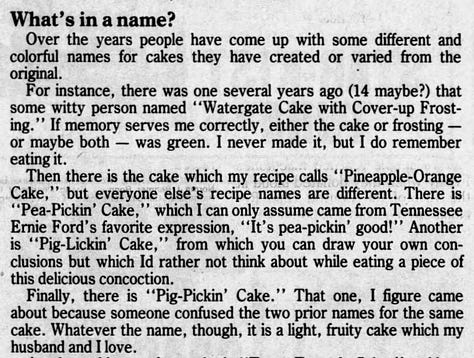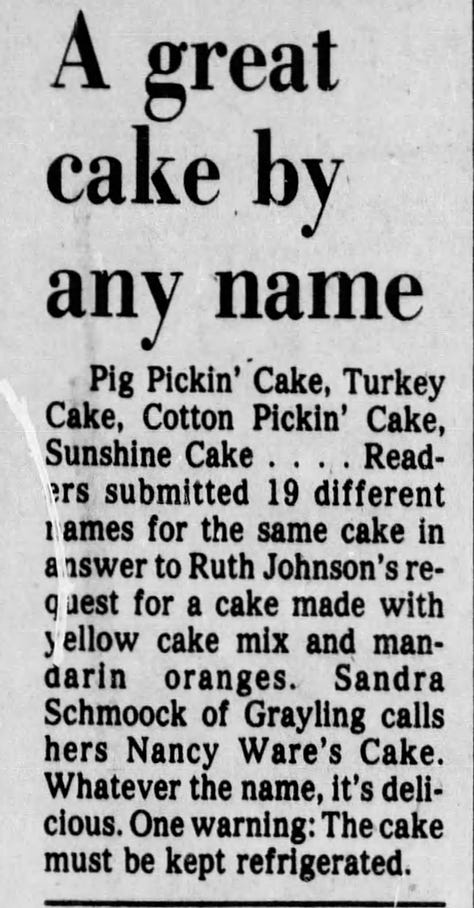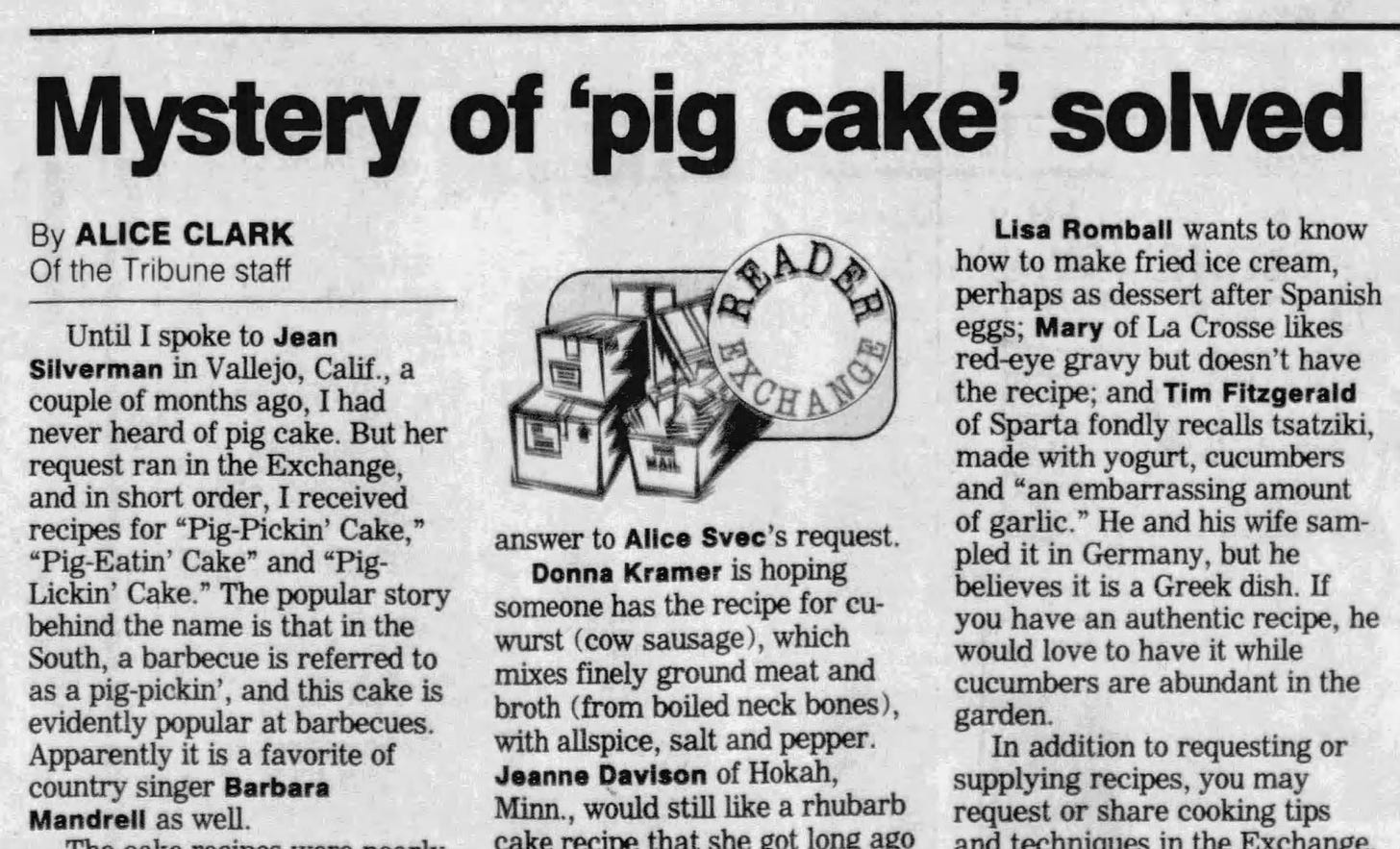The Chilling Legend of the Pig Pickin' Cake
Beware: this mysterious cake requires refrigeration!
When we first moved to North Carolina we frequently ate at a little barbecue joint down the road from town. You ordered at the counter and then sat in rickety plastic chairs at oil-cloth covered tables while they brought you your selections. The day’s desserts were written out on a dry-erase board: multiple types of pie, a couple cobblers, and often a multi-layer Pig Pickin’ Cake topped with bright orange canned mandarin slices. A cake, I was told by the women at the counter and by other locals later on, that was the traditional bake served with North Carolina pork barbecue and historically brought to community pig roasts called “pig pickings.” A tidy little food history moment…or so I thought. The plot, much like the powdered-pudding-laced whipped frosting for this cake, thickens.
This cake screams corporate intervention. Aside from the southern-based Duncan Hines cake, none of these ingredients are grown in the south. The warm hues and balmy clime origins of the mandarins and pineapple, however, are prime for sunny southern mythology marketing. The recipe is almost always printed with explicit brand references (Duncan Hines yellow cake, Cool Whip) regardless of known geographic brand loyalties and is that perfect balance of short and easy that you might see printed on the bottom of a pudding box or included as part of an coupon advertisement in the local paper. Every ingredient, except for the eggs, comes from a can or package. The rub: I can’t seem to figure out which brand came up with it.
Let’s turn to the name of the cake instead. The concept of a pig picking isn’t new, but the Pig Pickin’ Cake is a different story. According to food historian John Shelton Reed, North Carolinians didn’t really even use the expression “pig-picking” until the 1970s. Historically, pigs were typically slaughtered “on the first autumn or winter day after the weather had turned frigid,” which allowed people enough time to smoke, cure, and preserve meat before the winter and avoid any warm-weather insects that might be attracted to the cooking process. Nowadays, pig pickings are held any time there’s enough people to gather to eat a whole pig. Nevertheless, the autumnal connection endures. Reed offers this explanation in advance of a recipe for a Pig-Pickin’ Cake, which he says is just a variation of a Pineapple Dream Cake, in his book Barbecue: A Savor the South Cookbook (2016).
Starting in the 1970s, newspapers across the nation begin to question the origins of the Pig Pickin’ Cake. Some generalized it as monolithically Southern bake, others say it was a misunderstanding (due to those wacky southern accents, of course!) of the expression “Pea-Pickin’” which was already well known and associated with Tennessee-based American country music singer and television host, Ernie Ford. While hosting his self-named TV show, Ford coined the phrase, "Bless your pea-pickin' heart!" and also used it in his song writing. Interestingly, as his music career started to wane in the 1970s, Ford, along with his iconic phrase, became the spokesman for Nashville-based Martha White brand flour. Despite the clear potential for a Martha White origin story here, the cake doesn’t seem to come from there either.



Though there is clear disgust and disdain in the headlines, which seems to largely stem from readers worried about killing pigs, little is said about the other more concerning monikers for the cake and their ties to the South’s problematic history. Sure, casual racism was the norm in the 1970s and Southern mythology was reinforced by both indoctrinated southerners and non-southerners alike, but logistically speaking, cotton picking and pig picking are very different activities.
The Betty Crocker Sunshine Cake, referenced in several of the articles, is similarly made with a cake mix and a pudding-plus-whipped topping frosting, but it typically called for peaches and other fruits and not the classic Pig Pickin’ combo of pineapple and mandarin oranges. And in the grand history of cakes, these subtle differences matter. Which leads us to Nancy.
Who was Nancy Ware you might ask? I’m still not sure. There are numerous obituaries for Nancy Wares across the nation dating back decades and even a century or more. There was a Nancy Ware absolutely cleaning up the blue ribbons for baked goods (sadly no cakes though) on the county fair circuit in California in the 1960s. And there was a serial-style newspaper drama called Meal Ticket written by Fred Lape about a mother-daughter vaudeville act that featured two characters named Nancy and Lottie Ware from the 1930s. They never mention any cake though. Eventually the possessive apostrophe gets dropped and Nancy’s cake no longer belongs to her, but is her. And thus phrases such as “I’ve got Nancy Ware chilling in the fridge” become part of our collective cakelore.
To this day, the Nancy connection remains a mystery.
Pairs well with:

I made a Pig Pickin’ Cake (dolled up with olive oil and yuzu) for the recent Cake Pickin’ event that I cohosted with my friend and fellow baker Oona of While You’re Up Bakery. We were inspired to host our own cake picnics after seeing our friend Elisa of Salted Rye over on the west coast bring together so many people over cake. This was our second gathering which we renamed Cake Pickin’ in honor of our North Carolina home. The local student paper The Daily Tar Heel came to our pickin’ and wrote up a nice little story about us, too!










